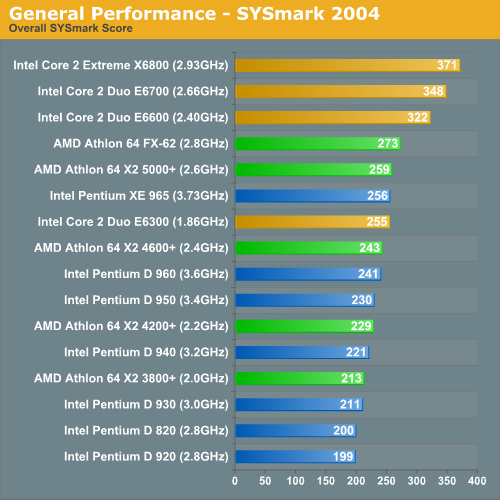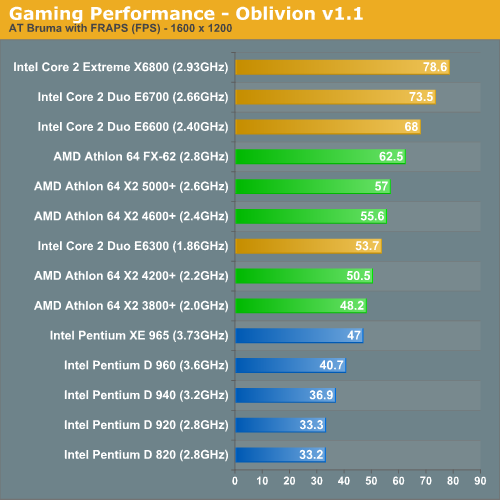AMD Athlon X2 7850 vs. Intel Pentium E5300: Choosing the Best $70 CPU
by Anand Lal Shimpi on April 28, 2009 11:00 AM EST- Posted in
- CPUs
$74 Gets You Faster than any Pentium 4 Ever Made
The Pentium E5300 is very similar in clock speed and cache size to some of the original Core 2 Duos that launched in the summer of 2006. You may recall that Intel offered both 2MB and 4MB L2 variants of the Core 2 at launch. The E6300 and E6400 both had a 2MB L2, while the E6600, E6700 and X6800 all had a 4MB L2.
The Pentium E5300 is based on the Wolfdale core, which is faster than the original Conroe based Core 2s - but it only has a 2MB L2 like the old E6400. The E6400 however ran at 2.16GHz, the E5300 runs at 2.60GHz. In other words, today’s $74 Pentium E5300 is faster than the original Core 2 Duo E6400.
But the comparison gets even more interesting. Remember that the E6400, at launch, was faster than even the fastest Pentium 4 - the dual core, four thread Pentium Extreme Edition 965 running at 3.73GHz. The charts below from my original Core 2 Duo review show just that:


Do you see where I’m going with this? While the data above is old, it shows that the E6400 was faster than the fastest Pentium 4 ever released. And the $74 E5300 is faster than the E6400, therefore the Pentium E5300 is faster than any Pentium 4 ever released.
Most people didn’t have 3.73GHz Pentium Extreme Editions in their systems - they had lower clocked versions, in which case the E5300 should be even faster. If you had a 2.8GHz Pentium D, I’d expect the Pentium E5300 to be anywhere between 20 - 40% faster regardless of application. Mmm Moore’s Law.
The Test
| Motherboard: | Intel DX48BT2 (Intel X48) MSI DKA790GX Platinum (AMD 790GX) |
| Chipset: | Intel X48 AMD 790GX |
| Chipset Drivers: | Intel 9.1.1.1010 (Intel) AMD Catalyst 8.12 |
| Hard Disk: | Intel X25-M SSD (80GB) |
| Memory: | G.Skill DDR2-800 2 x 2GB (4-4-4-12) G.Skill DDR2-1066 2 x 2GB (5-5-5-15) Qimonda DDR3-1066 4 x 1GB (7-7-7-20) |
| Video Card: | eVGA GeForce GTX 280 |
| Video Drivers: | NVIDIA ForceWare 180.43 (Vista64) NVIDIA ForceWare 178.24 (Vista32) |
| Desktop Resolution: | 1920 x 1200 |
| OS: | Windows Vista Ultimate 32-bit (for SYSMark) Windows Vista Ultimate 64-bit |










55 Comments
View All Comments
JimmiG - Tuesday, April 28, 2009 - link
Interesting to see the X4 9850 at 2.5GHz beating the higher clocked Phenom-derived Athlon X2 in many of the game tests. If multithreaded performance of games continue to improve, I think a Quad or Triple core CPU would be more future proof?The Phenom II X3 is a very nice AMD gaming CPU at this time and a tempting "sidegrade" even though I've already got a first-generation Phenom X4.
Davelo - Tuesday, April 28, 2009 - link
and then totally ignores it's original premise. I'm no fanboy but I find it very hard to miss the fact that the Intel solution costs almost $150 more when you factor in the added cost of the motherboard.Anand Lal Shimpi - Tuesday, April 28, 2009 - link
I used the X48 simply to allow for direct comparisons to all of the other CPU test data in Bench - www.anandtech.com/bench. The X48 performs similarly to the P45 and the P35 (and many other similar chipsets if you're not overclocking), so the comparison is still valid.Take care,
Anand
lopri - Tuesday, April 28, 2009 - link
What about power consumption comparison? Are you penalizing E5300 with X48 there? That'd be incredibly stupid and unfair to E5300.And this paragraph makes no sense to me. (literally)
Interesting review, nevertheless.
TA152H - Tuesday, April 28, 2009 - link
What he was trying to say was, the ideal cache set up for a quad-core is different from a dual-core. The quad-core is best with a relatively small and fast L2 cache, and a significantly larger L3 cache. The dual core is best with a relatively large L2 cache, and no L3 cache. Because AMD's processor is a quad-core stripped down to a dual-core, it has the cache hierarchy of the quad-core, even though it's a dual core now. So, it's not the ideal cache setup.edogawaconan - Tuesday, April 28, 2009 - link
Also worth noting that not all lower-end Intel processor includes VT-x which (arguably?) helps accelerating speed for tasks related to virtualization.stmok - Wednesday, April 29, 2009 - link
Actually, Intel's VT or AMD-V doesn't do much for performance. (You'll see this with VirtualBox. What it does provide is a more stable development approach to virtualization for the software programmer.)The one area where you will see a performance increase is with "nested paging". (A 2nd generation virtualisation feature).
In that case, the Phenom-based Athlon X2 clearly wins. NONE of the Core 2 series have nested paging, only Core i7 series...And this Core 2 doesn't have Intel VT either! Nested paging was introduced in all K10 based AMD CPUs. (Its also carried onto K10.5 or Phenom II processors).
nvmarino - Tuesday, April 28, 2009 - link
Considering the low price and low FSB/high multiplier of the E5300 makes it a perfect candidate for overclocking I'm surprised you guys didn't do some OC tests. Would be nice to see the impact of smaller cache at higher clocks.My e5300 does 3.7Ghz easily with a PoS air cooler.
aeternitas - Tuesday, April 28, 2009 - link
I think this review needs to be augmented with OC capabilities and the tests redone with them.Its highly unrealistic to test these at stock. The mass majority of people that would care about this review at this price are getting these cpus because of the insane bargain when OCed.
To not test that is really unrealistic. It makes this whole article much less usefull than it could have been.
nubie - Tuesday, April 28, 2009 - link
I went for the e5200 for $59 on ebay. Same chip but with a 12.5 multi instead of 13.I plan on running it well north of 3 ghz on a day to day basis, either 1066 or 1333 FSB. Even 1066 will get you a solid 3.4ghz, and it should be able to reach that easily on any motherboard.
You completely forgot to mention that this is the only 800mhz FSB line on a 45nm process, and thus can be overclocked in any motherboard, including $45 ones with a simple strap on the FSB pads.
I think that Intel is the clear winner, hands down, if you are an enthusiast with very little money who is not opposed to overclocking.